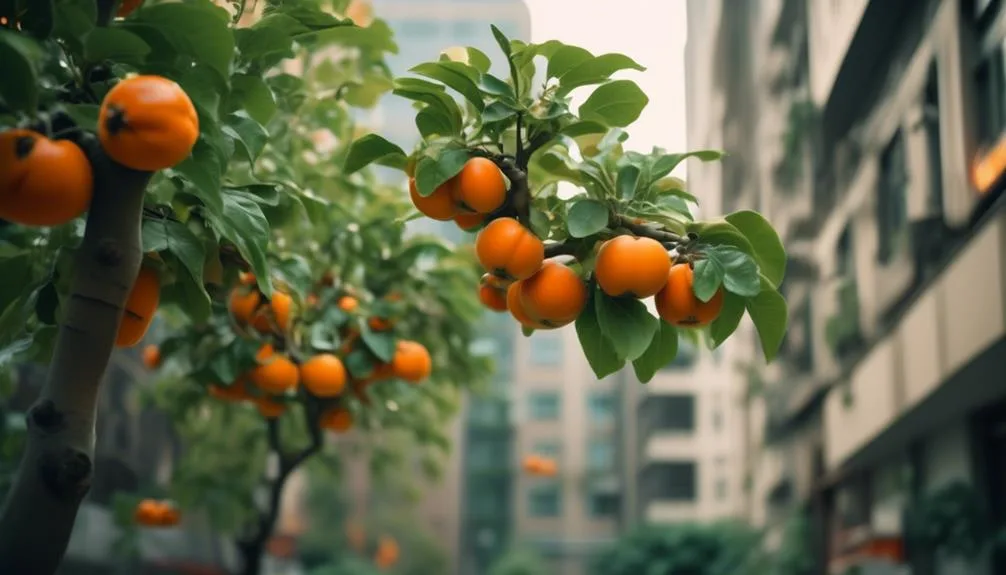Have you ever seen a persimmon tree thriving in the middle of a busy city? It's surprising, but these trees can actually do really well in urban areas.
How do they manage to survive and even thrive among all the buildings and traffic? Let's take a closer look at how persimmon trees can adapt to city life and find out what makes them so successful in this environment.
Key Takeaways
- Persimmon trees are well-suited for urban environments due to their adaptability and ability to thrive in diverse conditions.
- The trees provide numerous benefits to urban areas, including shade, improved air quality, and wildlife habitats.
- Despite challenges such as limited space and pollution, proper care and management can help persimmon trees overcome growth obstacles in urban settings.
- Urban persimmon cultivation offers sustainability, fresh fruit, and community-building opportunities while reducing reliance on external sources.
Urban Environment Suitability
Thriving persimmon trees can adapt well to urban environments, where they benefit from the rich diversity of available resources and can enhance the local landscape with their vibrant foliage and delicious fruit.
Urban tree diversity provides persimmon trees with a range of pollinators and support systems, ensuring their growth and fruit production.
Green space integration allows persimmon trees to thrive in urban settings, offering not only aesthetic benefits but also contributing to the overall environmental health of the area. These trees can transform urban landscapes into green oases, providing shade, improving air quality, and creating habitats for wildlife.
Their ability to thrive in diverse urban environments makes persimmon trees a valuable addition to city landscapes, enhancing the beauty and functionality of green spaces while providing delicious, nutritious fruit for urban dwellers.
Persimmon Tree Adaptability
Adapting well to urban environments, persimmon trees showcase remarkable resilience and flexibility in their ability to thrive amidst diverse landscapes and contribute to the overall environmental health of the area. Their adaptability makes them an ideal choice for urban landscaping, as they can withstand various environmental stressors commonly found in city settings. Here's a glimpse of the persimmon tree's adaptability:
| Adaptability | Description |
|---|---|
| Temperature | Tolerant of heat and cold, suitable for various climate zones |
| Soil Type | Thrives in a wide range of soil types, from clay to loamy |
| Pollution | Resilient to urban pollution, enhancing air quality |
| Space | Can be pruned to fit small urban spaces |
| Pest Resistance | Displays natural resistance to pests and diseases |
Persimmon trees' adaptability not only adds aesthetic value to urban landscapes but also contributes to a healthier and more sustainable urban environment.
Growth Challenges in Urban Areas
Despite their adaptability, persimmon trees face a variety of growth challenges in urban areas that require careful management and attention to ensure their continued health and vitality. These challenges include:
- Soil Quality and Pollution: Urban environments often have poor soil quality due to compaction and pollution, which can hinder the tree's ability to access essential nutrients and water.
- Space Constraints and Competition: Limited space in urban settings can lead to increased competition for resources such as sunlight, water, and nutrients, impacting the tree's growth and overall health.
- Air Pollution: Urban areas are often plagued by air pollution, which can negatively affect the tree's respiratory functions and overall vigor.
Managing these challenges through proper soil maintenance, adequate spacing, and pollution control measures is crucial to supporting the successful growth of persimmon trees in urban environments.
Benefits of Urban Persimmon Cultivation
Urban persimmon cultivation offers numerous benefits for both the environment and the community, contributing to improved air quality, green spaces, and a sustainable source of fresh fruit. Community gardening initiatives with urban fruit trees like persimmons not only provide a local source of nutritious produce but also foster a sense of community and connection to the natural world. Here's a glimpse of the various benefits of urban persimmon cultivation:
| Benefits | Description |
|---|---|
| Improved Air Quality | Persimmon trees absorb pollutants and release oxygen, enhancing the air quality in urban areas. |
| Green Spaces | Persimmon orchards contribute to the creation of green spaces, providing aesthetic appeal and fostering biodiversity. |
| Sustainable Fresh Fruit | Community members can enjoy the delicious and nutritious fruits while reducing their reliance on external sources. |
| Community Bonding | Community gardening around persimmon trees fosters a sense of togetherness and pride in cultivating a sustainable urban environment. |
Best Practices for Urban Persimmon Care
For successful urban persimmon cultivation, it's essential to implement effective care practices that promote tree health and fruit production. To ensure the thriving of persimmon trees in urban environments, consider the following best practices:
- Pruning Techniques: Regularly prune persimmon trees to remove dead or diseased branches, improve air circulation, and shape the tree for optimal fruit production. Pruning also helps control the tree's size, making it more suitable for urban spaces.
- Soil Quality: Ensure the persimmon tree is planted in well-draining, loamy soil with a slightly acidic to neutral pH. Amending the soil with organic matter can improve its structure and fertility, promoting healthy root growth and overall tree vigor.
- Watering and Nutrient Management: Provide adequate water during the growing season, and consider fertilizing the tree with a balanced fertilizer to support fruit development and overall tree health.
Conclusion
In urban environments, persimmon trees thrive with proper care and maintenance, offering delicious fruit, shade, and beauty.
Their resilience in the face of city challenges makes them an ideal choice for urban cultivation.
Consider adding a persimmon tree to your city landscape and witness its flourishing impact.

